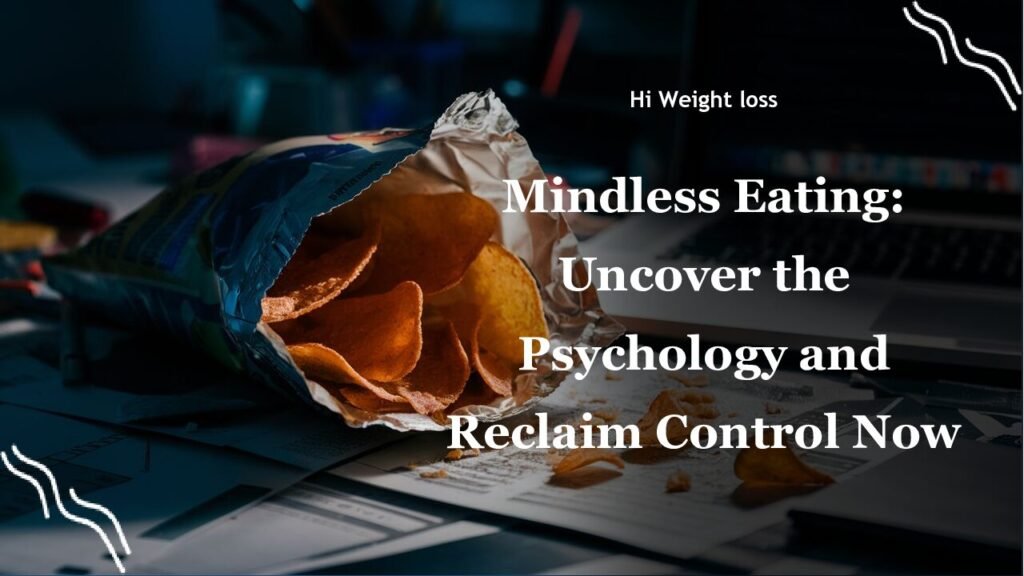“`
Ever found yourself reaching for that bag of chips, not because you’re hungry, but simply because it’s there? This is a common experience for many of us, and it highlights the problem of mindless eating. It’s not just about lack of willpower, but rather, a complex set of psychological factors that drive us to consume food without even realizing it, often leading to overeating and unhealthy habits. In this article, we’ll explore the *psychology of mindless eating*, examining its triggers, causes, and most importantly, what you can do to take back control of your eating habits.
Understanding the Psychology of Mindless Eating
Mindless eating is more than just a bad habit. It’s a complex issue rooted in how our minds process cues and emotions related to food. Let’s delve into the key psychological factors that contribute to this behavior. Have you ever considered how much your environment shapes your eating patterns?
The Role of Lack of Awareness in Mindless Eating
One of the primary drivers of mindless eating is simply a lack of awareness. When we are distracted, say by binge-watching our favorite show, or engrossed in work, our attention is drawn away from the act of eating. This lack of focus means we aren’t registering our hunger and fullness cues, which can easily lead to overconsumption. I remember once, during a particularly intense work week, I ate an entire bag of popcorn during a video call without even realizing it! This really made me understand how much my mind was elsewhere.
According to Healthline, distraction can lead to overeating or eating more than necessary.
External Cues: How Your Environment Affects Your Eating Habits
Our environment plays a significant role in our eating habits. External cues, like seeing food commercials, the aroma of freshly baked bread, or simply the presence of readily available snacks, can trigger the urge to eat even when we’re not genuinely hungry. Think about those tempting displays at the checkout line in a grocery store—they are designed to make you buy more than what’s on your list. These environmental triggers often cause us to eat out of habit or impulse, instead of actual hunger. A friend of mine told me how she always reaches for snacks at movie theaters, not out of hunger, but because it feels like the “thing to do.” These *external cues* can be powerful.
Also, Healthline notes that eating can be triggered by external cues.
Emotional Eating: When Food Becomes a Coping Mechanism
Do you ever find yourself reaching for comfort food when you’re stressed, bored, or sad? This is a classic example of emotional eating. For many, food becomes a coping mechanism to deal with uncomfortable emotions. Eating can offer a temporary distraction from these feelings, but it doesn’t address the root cause and often leads to feelings of guilt or shame afterward. I have a friend who used to eat ice cream after every stressful day. Once she realized the pattern, she began finding healthier ways to manage her stress, like going for a walk or listening to music. *Emotional eating* is a common trap, but awareness is the first step to change.
According to Healthline, mindless eating can be a coping mechanism for emotional states like stress, anxiety, or boredom.
Sensory-Specific Satiety: Why Variety Matters
Ever notice how that first bite of a meal is the most satisfying? That’s partly due to a phenomenon called sensory-specific satiety. When you eat the same flavor or texture repeatedly, your senses become less stimulated, and you need more of that food to feel satisfied. This is one reason why buffets can be so dangerous for *mindless eating*; the variety of food keeps your senses engaged, making it easier to overeat. The trick here is to introduce variety into your meals to prevent yourself from eating more than you need.
As Healthline points out, the repeated exposure to the same flavors or textures can lead to a numbing effect.
Mindless Eating as a Behavioral Habit
Many of our eating habits are just that—habits. Mindless eating often becomes a behavior we perform without much thought or awareness. This can be because food is so readily available, and we often eat while doing other things. Think of your commute home and the automatic stop at a drive-through. It’s something you might do without thinking about it. Breaking those ingrained habits can be challenging, but it’s essential to becoming a more mindful eater. These kinds of habits are difficult to break, but not impossible!
According to a study by the University of Pittsburgh, mindless eating can be performed without much thought or awareness.
The Impact of Marketing on Mindless Consumption
Even so-called “healthy” foods can fall victim to our *mindless eating* tendencies, thanks to clever marketing tactics. Labels like “low-fat” or “sugar-free” often create a “health halo” effect, leading us to consume more, assuming it’s a guilt-free option even if the calorie content is still high. These marketing tactics can make us less aware of what we’re actually eating. It’s important to look beyond the labels and pay attention to actual nutritional information. Be aware, and you can avoid this common pitfall.
According to Healthline, even healthy foods can be consumed mindlessly due to clever marketing strategies.

Strategies to Combat Mindless Eating
Now that you’re more aware of the psychological drivers of mindless eating, you’re probably wondering how to break free of this cycle. It’s absolutely possible, with the right approach. Here are several practical strategies to consider:
- Slow Down and Savor: When you eat, make it the main event. Put away your phone, turn off the TV, and focus on the taste, texture, and smell of your food. Eating slower gives your body a chance to register fullness.
- Pay Attention to Hunger Cues: Before grabbing a snack, ask yourself, “Am I truly hungry, or am I just bored, stressed, or tired?” Learn to differentiate between physical hunger and emotional cravings.
- Control Your Environment: Make healthy options readily available, and keep less healthy choices out of sight, or don’t buy them in the first place. Store leftovers out of sight so you are not drawn to snack on them.
- Plan Your Meals: Plan your meals ahead of time so you’re not reaching for whatever is easiest. You will be more likely to stick to healthier choices.
- Practice Mindful Eating: Engage all your senses while eating. Notice the colors, aromas, and textures of your food. This keeps you present in the moment and reduces mindless consumption.
- Manage Stress: Find alternative ways to cope with stress or other uncomfortable emotions, instead of turning to food.
Data on Mindless Eating
Here is some interesting data on mindless eating:
| Aspect | Details |
|---|---|
| Distracted Eating | Associated with consuming more calories and less awareness of food intake. |
| Emotional Eating | Often leads to overeating and poor food choices. |
| External Cues | Visual and aroma cues strongly trigger eating regardless of hunger. |
| Sensory-Specific Satiety | Reduced satisfaction with monotonous flavors leads to greater consumption. |
| Marketing Influences | “Healthy” food labels can promote overeating through the “health halo” effect. |
Conclusion
The *psychology of mindless eating* is a complex interplay of various factors, ranging from lack of awareness and emotional triggers to external cues and ingrained habits. It’s important to understand that mindless eating isn’t a matter of lack of willpower, but often a response to the environment and our emotional states. Remember my popcorn story during the stressful workday? It’s a perfect example of how easily we can fall into mindless eating patterns when we aren’t paying attention to our body and its signals. However, by understanding these psychological drivers and implementing strategies such as slowing down, paying attention to your hunger cues, and practicing mindfulness, you can regain control over your eating habits. Small, consistent steps toward mindful eating can lead to significant improvements in your relationship with food and your overall health. Start by picking one strategy today and see how it can make a difference.
FAQ
What exactly is considered mindless eating?
Mindless eating refers to consuming food without being fully aware of the act. This often happens when you’re distracted, such as watching TV, working, or during a social event. You’re not paying attention to the taste, texture, or your body’s hunger signals.
How can I distinguish between emotional eating and genuine hunger?
Genuine hunger is a gradual build-up of a physical need for food that’s associated with physical sensations such as stomach rumbling. Emotional hunger, on the other hand, is often sudden, linked to emotions such as stress, boredom or sadness, and it often involves the desire for specific comfort foods, like ice cream or pizza.
What are some practical ways to practice mindful eating?
To practice mindful eating, focus on eating in a calm environment, engage all your senses, and pay attention to your hunger and fullness cues. Put your utensils down between bites, chew slowly, and enjoy the flavors and textures of each bite. Turn off all distractions, like the TV or your phone.
“`



